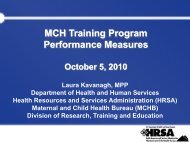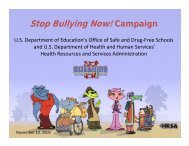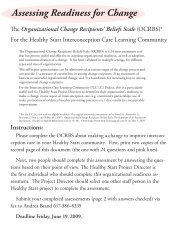Pediatric Case Studies - HRSA
Pediatric Case Studies - HRSA
Pediatric Case Studies - HRSA
Create successful ePaper yourself
Turn your PDF publications into a flip-book with our unique Google optimized e-Paper software.
PEDIATRIC CASE STUDIES: EMERGENCY DEPARTMENT TRIAGE<br />
and answers your questions appropriately. He is currently taking no medications. T<br />
98F (36.7 C) HR 82 RR 14 BP 128/80.<br />
9) EMS radios to say they are en route with a 5 year old girl who aspirated a balloon at<br />
a birthday party. She is alert but drooling and unable to speak. HR 124 RR 28 sat 99%<br />
on blow by oxygen.<br />
10) “I just realized my son is out of his asthma medicine and we’re going on vacation in<br />
the morning, can you give him some more just in case he needs it?" The father of a 6<br />
year old boy asks you. The child is climbing on and off his father’s lap and playing with<br />
your blood pressure cuff. He has good color and is breathing comfortably. His father<br />
says he has not been sick or wheezed recently.<br />
11) A 9-year-old boy presents to the emergency department with his parents who<br />
request he be checked because he has a severe shellfish allergy and he mistakenly ate<br />
a dip that may have contained shrimp. Mom says she administered the child’s epi pen.<br />
The boy tells you that he feels ok, just “kind of shaky”. No wheezes or rash noted. T 97<br />
(36.1 C) HR 118, RR 20, SpO2 97% BP 116/74.<br />
12) “She keeps running to the bathroom” says the grandmother of an 8-year-old girl.<br />
Grandma requests to see a doctor because she thinks the child has a possible urinary<br />
tract infection. The child says “it hurts to pee”. She says her tummy doesn’t hurt and<br />
Grandma says she hasn’t noticed anything different about child’s underwear when you<br />
ask about vaginal discharge. T. 97.4 (36.3 C), HR 88, RR 20, BP 122/70.<br />
13)A 3 year old boy is brought to triage by his mom who tells you he cut his hand on a<br />
glass while he was trying to help her wash the dishes. You note a 3 cm jagged cut on<br />
his hand with no active bleeding. When you try to examine the wound he screams and<br />
pulls away, trying to hit you with his other hand. T 98 (36.7 C) HR 110 RR 26 BP<br />
100/68.<br />
14) A two year old is brought in by his mother for a fever. She states that he has been<br />
fussy at home and eating less than usual but is drinking well. She tells you that she<br />
thinks immunizations give you autism and her son has not had any of his shots. The<br />
child is fussy but alert, with no obvious source for his fever on your exam. T 39<br />
(102.2F) HR 140 RR 24 sat 98% RA.<br />
15) He has rashes on his asses” the mother of a 14 month old boy tells you. The child<br />
is alert, playful, is breathing normally and has good color. When you remove his diaper<br />
to take his temperature, you note that his buttocks are reddened and he has a macularpapular<br />
rash. The rash is only in his diaper area. His diaper is slightly wet. T 99 (37.2<br />
C) HR 110 RR 26.<br />
Funded by Grant H34MCO4371 From the Health Resources and Services Administration/<br />
Maternal and Child Health Bureau’s Emergency Medical Services for Children Program.<br />
© 2010 University of North Carolina at Chapel Hill<br />
2




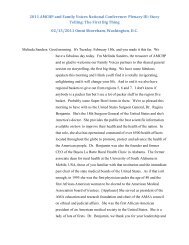



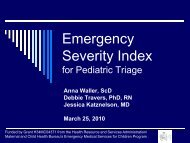
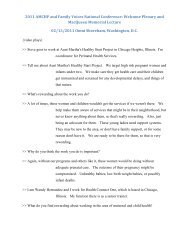
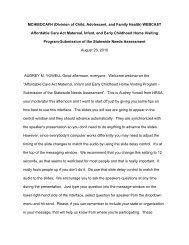
![Hormone Disruptors and Women's Health: Reasons for Concern [PDF]](https://img.yumpu.com/19410002/1/190x245/hormone-disruptors-and-womens-health-reasons-for-concern-pdf.jpg?quality=85)

